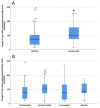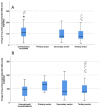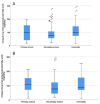Omega-3 Long-Chain Polyunsaturated Fatty Acids Intake in Children: The Role of Family-Related Social Determinants
- PMID: 33187190
- PMCID: PMC7697719
- DOI: 10.3390/nu12113455
Omega-3 Long-Chain Polyunsaturated Fatty Acids Intake in Children: The Role of Family-Related Social Determinants
Abstract
Omega-3 long-chain polyunsaturated fatty acids play a central role in neuronal growth and in the development of the human brain, since they are essential elements which depend on intake through diet to ensure an adequate amount. Fish and seafood are the main dietary sources of these fatty acids in Spain and in other countries. In order to assess the effect of the intake of common foods containing high amounts of omega-3 polyunsaturated fatty acids, a food frequency questionnaire was administered to parents of children and adolescents attending a primary school in Valencia (Spain), and the intake of dietary omega-3 such as eicosapentaenoic acid (EPA) and docosahexaenoic acid (DHA) was estimated based on their fish/seafood consumption. Low frequencies of intake were significantly (p < 0.05) lower for many types of fish/seafood in children compared to adolescents. 27.5% of children/adolescents did not eat lean fish or other types (19.8% of the sample did not eat fatty fish, and 71.8% did not eat smoked fish) and 20-60% of the sample consumed seafood only once-three times a month, leading to a reduced estimated intake of EPA+DHA below that recommended for both groups by public health agencies. Social aspects, such as the type of work done by mothers and their educational levels are significant factors (p < 0.05 in both cases) affecting children's/adolescents' intake of DHA+EPA. Dietary interventions to increase the consumption of fish and seafood are strongly advised, and health promotion strategies should be aimed at the family level and fight against gender disparities.
Keywords: ADHD; children; diet-deficient; fish intake; nutrients; omega-3 fatty acids.
Conflict of interest statement
The authors declare no conflict of interest.
Figures




References
-
- Newberry S.J., Chung M., Booth M., Maglione M.A., Tang A.M., O’Hanlon C.E., Wang D.D., Okunogbe A., Huang C., Motala A., et al. Omega-3 Fatty Acids and Maternal and Child Health: An Updated Systematic Review. Evid. Rep. Technol. Assess. 2016;224:1–826. - PubMed
-
- Simopoulos A.P. Human requirement for N-3 polyunsaturated fatty acids; Proceedings of the Poultry Science, Poultry Science Association; Montreal, QC, Canada. 18–20 August 2000; pp. 961–970. - PubMed
-
- Rendeiro C., Sheriff A., Bhattacharya T.K., Gogola J.V., Baxter J.H., Chen H., Helferich W.G., Roy E.J., Rhodes J.S. Long-lasting impairments in adult neurogenesis, spatial learning and memory from a standard chemotherapy regimen used to treat breast cancer. Behav. Brain Res. 2016;315:10–22. doi: 10.1016/j.bbr.2016.07.043. - DOI - PubMed
MeSH terms
Substances
LinkOut - more resources
Full Text Sources
Research Materials

